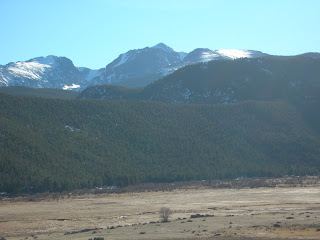While out there I did some cycling with him [ I am trying hard to believe that his choice of speed and terrain had more to do with his strength and enthusiasm and less to do with collecting my life insurance] and without him and some hiking with Daniel, some with Jean, and some solo. Daniel lives and works in Fort Collins, a very bike friendly town, where he survives with 2 bikes and no cars. The town is pretty flat but the challenging foothills start right at the edge of town. People are very friendly and mostly physically fit. Even casual riders often move at near 20 mph.
We spent four days in Rocky Mountain National Park hiking along trails that led to lakes or mountain tops. I felt the reduced air at 10,000 feet, moving even slower than my usual "deliberate" pace. The trails are not marked very well and with snow covering the footbed they are difficult to follow. Daniel and Jean's cousin's husband, Joe, and I spent about 3 hours last Saturday following false tracks on Flat Top Mountain , sometimes through 8 foot deep snows, before finally locating the right trail to the summit. By then time and energy were running out so we headed home. Views were still great, but I regretted missing the top by such a wide margin. The three Cherdacks did a nice stream side walk on Sunday, the bright sun contrasting with the snows on the mountains.
Elk were plentiful and some areas were fenced in to keep the elk out and allow plants to regenerate. The elk looked pretty ragged this time of year as they shed their winter coats. Despite melting the snows, the forests and meadows looked pretty dry; this and the prematurely warm weather are making forest fires a real danger.
Jean and I went back to the park Tuesday night and Wednesday I hiked up to the summit of Flat Top solo. I saw only 5 other people on the mountain all day. The trip was about 9 miles with about 3,000 feet of gain... not much different from a hike to major peak in the Adirondacks of New York, but the altitude had a major effect on me. I used snowshoes on Saturday, but I used crampons for much of the hike on Wednesday.
Here comes some physics. Skip it if you must, but don't tell me; I'd rather not know
Since static pressure at a point is caused by weight of fluid above that point we have
delta P/delta y = - density of air x g ( force of gravity per kg or 9.8 N/kg). In other words the force on a square meter ( pressure, P) declines ( thus the negative sign) by the weight of one cubic meter of air ( density x g) when every you go up ( in the positive y direction) by one meter.
Pressure P is related to the number of moles of gas per cubic meter ( n/V) by
P=n/V R( Universal gas constant of 8.31) x T(temperature in Kelvin which was about 300)
So P = n/V x 8.31 x 300 or n/V = P/2500
Also the density of air = (n/V) x kg mole of air and
air has a density of about .029 kg/mole. Thus we have density = n/V x .029
delta P/delta y = -(n/V)x.029 x9.8 = -(P/2500) x.029 x9.8 = -P/8772 ( Pascals/m) [ A Pascal is 1 Newton of force per square meter of area]. The solution to the equation is
P = Pat sea level(which is 101,000 Pascals) x e ( or 2.78 the base of natural logs) ^-y ( height above sea level)/8772
or P = 101,000 Pascals e^-y/8772.
Flat Top Mountain is about 4,000 m high so the pressure on top is about
101,000 x e ^- (4000/8772) or about 63% of what it is at sea level.
The hike was great and the view were wonderful, more than 40 snow covered peaks to the north and west, some classic pyramids, others blocky, cliff seamed piles. Deep canyons and many lakes to be seen as well. Here are some photos from near the lakes and meadows at about 9,000 feet. The last picture is from our cabin where we stayed Wednesday.



